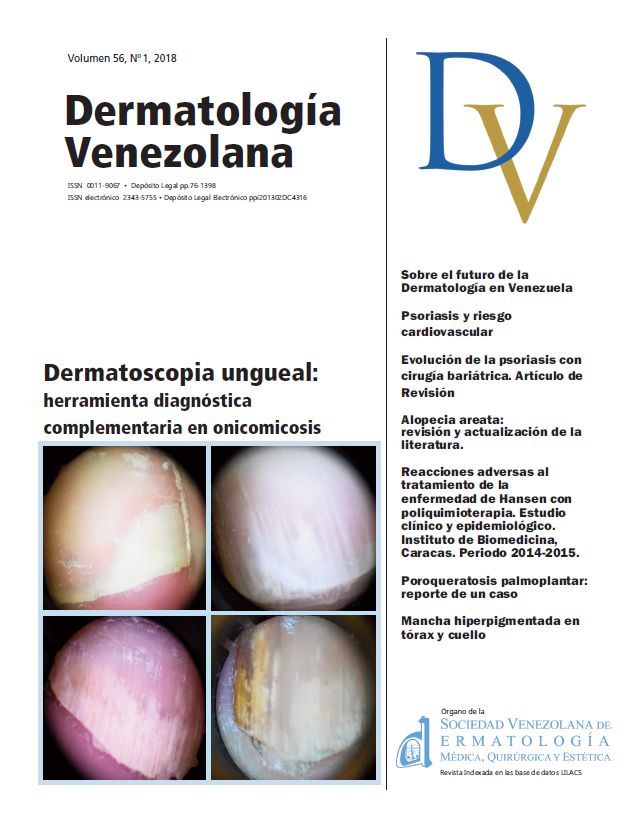Alopecia areata: revisión de la literatura
Palabras clave:
Alopecia areata, pérdida de cabello, alopecia no cicatricial, reversible, folículo pilosoResumen
La alopecia areata (AA) es un tipo de alopecia no cicatricial, caracterizada por una pérdida del cabello transitoria y reversible, mediada inmunológicamente, con preservación del folículo piloso, que causa un impacto psicosocial importante. En cuanto a su mecanismo fisiopatológico ocurre una disrupción del inmunoprivilegio del folículo piloso, con posterior alteración del ciclo del mismo. La lesión principal de la AA es una placa redonda u ovalada, bien delimitada, calva, lisa, brillante, de consistencia blanda, siendo su principal localización el cuero cabelludo. Con el dermatoscopio se hacen más evidentes los pelos cortos, con el extremo proximal más delgado que el distal (signo de exclamación), así como los característicos puntos amarillos y negros. Es recomendable realizar medidas terapéuticas precoces para evitar su progresión a pesar de que el 80% puedan tener una regresión espontánea en casos de baja severidad. En este artículo hacemos una revisión con el fin de actualizar la fisiopatología, clínica, métodos diagnósticos y nuevas medidas terapéuticas de la alopecia areata.
Alopecia areata: review of the literature.
Summary.
Alopecia areata (AA) is a type of noncicatricial alopecia, characterized by an immune mediated, reversible and transitory hair loss, with preservation of the hairy follicle that causes an important psychological impact. Its pathophysiological mechanism consists in a disruption of the immunoprivilege of the hair follicle, with subsequent alteration of its cycle. The main lesion of AA is a well-defined round or oval plaque, bald, smooth and bright, with soft consistency. Its primary location is the scalp. With the dermatoscope the short hairs become more evident, with the proximal end thinner than the distal one (exclamation mark), as well as the characteristic yellow and black dots. It is advisable to perform early therapeutic measures to prevent progression despite the fact that 80% may have a spontaneous regression in cases of low severity. In this article we review and update to update the pathophysiology, clinical manifestation, diagnostic methods and new therapeutic measures of alopecia areata. Key words: alopecia areata, hair loss, non cicatricial alopecia, reversible, hairy follicle.
Referencias
Davis D, Callender V, Review of quality of life studies in women with alopecia. Int J Womens Dermatol. 2018. 4 18–22
Guerrero R, Kahn M, Alopecias. REV. MED. CLIN. CONDES - 2011; 22(6) 775-783.
Saed S, Ibrahim O, Wilma F. Hair camouflage: A comprehensive review. Int J Womens Dermatol. 2016 Dec; 2(4): 122–127.
Pratt CH, King LE, Messenger AG y col. Alopecia areata. Nat Rev Dis Primers. 2017;3(17011).
Villasante Fricke AC, Miteva M. Epidemiology and burden of alopecia areata: a systematic review. Clin Cosmet Investig Dermatol. 2015;24(8): 397-403.
Thompson JM, Park MK, Qureshi AA. Race and Alopecia Areata amongst US Women. J Investig Dermatol Symp Proc. 2018;19(1): S47-S50.
Strazzulla LC, Wang EHC, Avila L. Alopecia areata: Disease characteristics, clinical evaluation, and new perspectives on pathogenesis. J Am Acad Dermatol.2018;78(1): 1-12.
Lemos MA, Díaz CJ, Moreno LH. El inmunoprivilegio del folículo piloso. J Am Acad Dermatol. 2017;78(1): 1-12.
Galán Gutiérrez M, Rodríguez Bujaldón M, Moreno Giménez J. Update on the treatment of alopecia areata. Actas Dermosifiliogr 2009;100:266-76
Martínez-Suárez H, Alopecia areata. Dermatol Rev Mex 2015;59:395-405.
Karina J, Juárez R, Rivera Sánchez et al. Alopecia areata. Actualidad y perspectivas Arch. argent. pediatr. 2017. 115:6 404-411.
Perera E, Yip L, Sinclair R (2014) Alopecia Areata. Hair Ther Transplant 4: 118.
Korta DZ1, Christiano AM2, Bergfeld W et al Alopecia areata is a medical disease J Am Acad Dermatol. 2018 Apr;78(4):832-834.
Waśkiel A1, Rakowska A1, Sikora M Trichoscopy of alopecia areata: An update. J Dermatol. 2018 Mar 22.
Chelidze K, Lipner S, Nail changes in alopecia areata: an update and review. Int J Dermatol. 2018. 1:1-8
Strazzulla L, Chun Wang E, Avila L, et al. Alopecia areata: Disease characteristics, clinical evaluation,and new perspectives on pathogenesis. J Am Acad Dermatol. 2018 Jan;78(1):1-12.
Vañó S, Hermosa A, Sánchez. Pulse corticosteroid therapy with oral dexamethasone for the treatment of adult alopecia totalis and universalis. J Am Acad Dermatol 2016: vol 74-5
Tosti A, Piraccini BM, Pazzaglia M et al. Clobetasol propionate 005% under occlusion in the treatment of alopecia totalis/universalis. J Am Acad Dermatol.2003;49(1): 96-8
Strazzulla LC, Wang EHC, Avila L y col. Alopecia areata: An appraisal of new treatment approaches and overview of current therapies. J Am Acad Dermatol. 2018;78(1): 15-24.
Tw CHU, Aljasser M, Alharbi A. Benefit of different concentrations of intralesional triamcinolone acetonide in alopecia areata: An intrasubject pilot study. J Am Acad Dermatol. 2015;73(2): 338-40.
Tan E, Tay YK, Goh CL y col. The pattern and profile of alopecia areata in Singapore--a study of 219 Asians. Int J Dermatol. 2002;41(11): 748-53.
Luggen P, Hunziker T. High-dose intravenous corticosteroid pulse therapy in alopecia areata:Own experience compared with the literature. J Dtsch Dermatol Ges.2008;6(5): 375-8.
Olsen EA, Carson SC, Turney EA. Systemic steroids with or without 2% topical minoxidil in the treatment of alopecia areata. Arch Dermatol. 1992;128(11): 1467-73.
Yang C-C, Lee C-T, Hsu C-K. Early Intervention with High-Dose Steroid Pulse Therapy Prolongs Disease-Free Interval of Severe Alopecia Areata: A Retrospective Study. Ann Dermatol. 2013;25(4): 471–474.
Vazquez veiga H. Minoxidil en el tratamiento de la alopecia areata. Med Cutan Iber Lat Am.2006. 34(2), 93-95.
Mackay-wiggan J, Jabbari A, Nguyen N et al. Oral ruxolitinib induces hair regrowth in patients with moderate-to-severe alopecia areata. JCI Insight. 2016;1(15): e89790
Jabbari A, Sansaricg F, Cerise J et al. An Open-Label Pilot Study to Evaluate the Efficacy of Tofacitinib in Moderate to Severe Patch Type Alopecia Areata, Totalis and Universalis. J Invest Dermatol. 2018;S0022-202X(18): 30117-9.
Bayart CB, Deniro KL, Brichta L et al. Topical Janus kinase inhibitors for the treatment of pediatric alopecia areata. J Am Acad Dermatol. 2017;77(1): 167-170.
Lynch MD, Bashir S. Applications of platelet-rich plasma in dermatology: A critical appraisal of the literature. J Dermatolog Treat. 2016;27(3): 285-9.
Trink, A, Sorbellini, E, Bezzola, P, Rodella, L. A randomized, double-blind, placebo and active-controlled, half-head study to evaluate the effects of platelet rich plasma on alopecia areata. Br J Dermatol. 2013;169(3): 690-4.
Shumez H, Prasad PVS, Kaviarasan PK et al. Intralesional platelet rich plasma vs intralesional triamcinolone in the treatment of alopecia areata: a comparative study. Int J Med Res Health Sci. 2015; 4: 118–122
Strazzulla LC, Avila L, Lo sicco K, Shapiro J. An Overview of the Biology of Platelet-Rich Plasma and Microneedling as Potential Treatments for Alopecia Areata. J Invest Dermatol. 2017;S0022-202X(17): 32751-3.
Spano F, Donovan J Alopecia areata: treatment. Can Fam Physician. 2015 Sep;61(9):757-61.
Adel Alsantali Alopecia areata: a new treatment plan. Clin Cosmet Investig Dermatol. 2011; 4: 107–115.
Mlacker S, Aldahan AS, Simmons BJ, Shah V. A review on laser and light-based therapies for alopecia areata. J Cosmet Laser Ther. 2017;19(2): 93-99.
Descargas
Publicado
Número
Sección
Licencia
Publicado por la Sociedad Venezolana de Dermatología Médica, Quirúrgica y Estética







